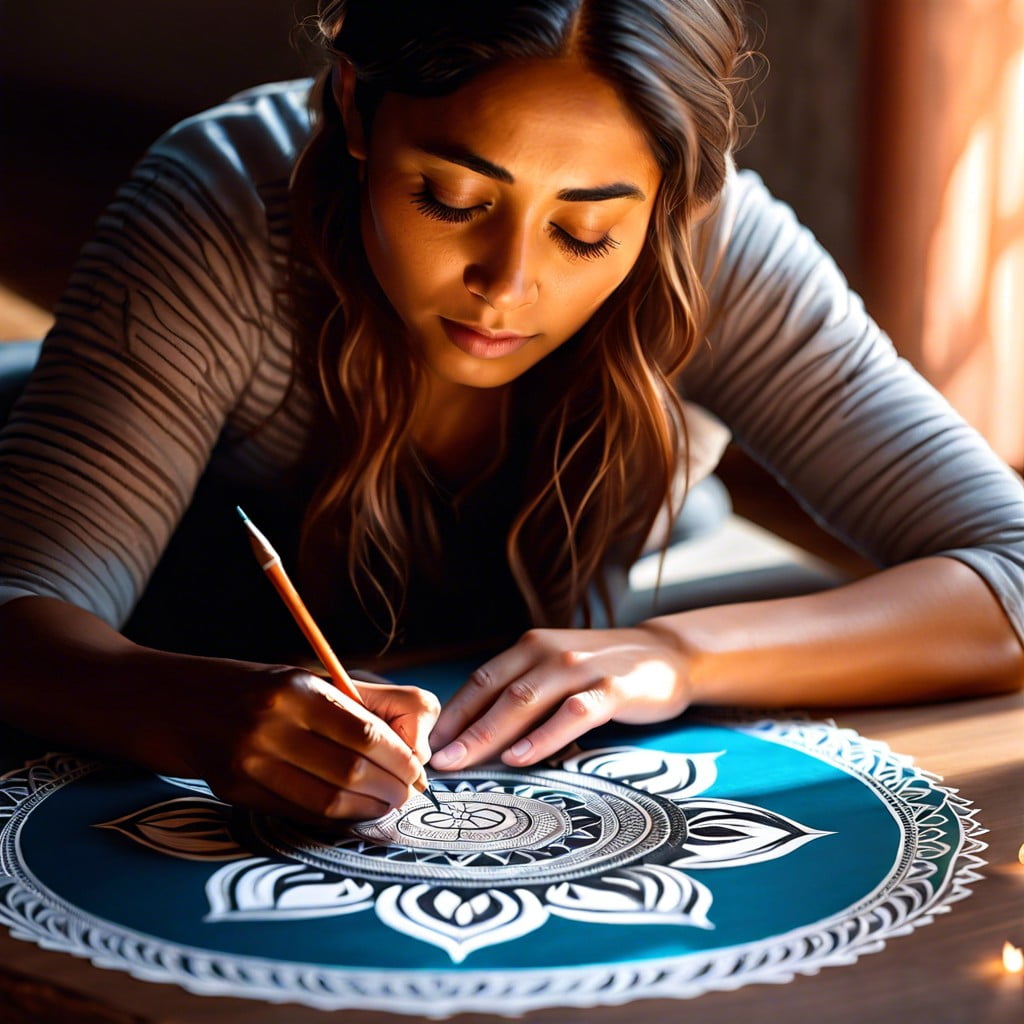This article will guide you through the steps of practicing meditation drawing to enhance mindfulness and creativity.
Key takeaways:
- Meditation drawing promotes relaxation and mindfulness through drawing.
- It is a non-judgmental practice that focuses on the process.
- Meditative drawing enhances sensory experiences and mindfulness skills.
- Materials such as paper, pens, pencils, and colored pencils can enhance the experience.
- Start a drawing meditation session in a quiet, comfortable space, using deep breaths to center the mind.
What Is Meditative Drawing?

Meditative drawing combines art therapy and meditation, promoting relaxation and focus through the act of drawing. This form of creative meditation is accessible to anyone, regardless of artistic skill. It encourages present-moment awareness by concentrating on lines, shapes, and patterns, making it an excellent practice for quieting the mind and reducing stress.
One key aspect is its non-judgmental nature. You’re not aiming to produce a masterpiece but rather to engage in a process that soothes your mind. The repetitive motion of drawing helps to stabilize the breath and anchor you in the moment.
By integrating mindful observation, meditative drawing also heightens your sensory experiences. You may notice more intricate details in your surroundings, enhancing your overall mindfulness skills.
Overall, this practice offers a pathway to explore your internal landscape without the pressure of critique, fostering a deeper connection with your inner self while tuning out external distractions.
Meditative Drawing for Mindfulness: The Basics
Meditative drawing combines the calming practices of meditation with the creative process of drawing. This art form doesn’t focus on the finished piece but rather on the act of drawing itself. The repetitive motion and focused attention help quiet the mind and can induce a meditative state, similar to using a mantra or focusing on breathing.
When you engage in this form of drawing, you allow spontaneous shapes and patterns to flow from your pen or pencil. This non-judgmental approach is key; there’s no right or wrong here. Each stroke serves as a moment of connection between mind and body, anchoring you in the present.
Practicing regularly nurtures a mindful routine, enhances concentration, and reduces stress. It’s an accessible method to cultivate mindfulness, requiring no previous artistic skills, only a willingness to draw freely.
Materials for Drawing Meditation
Choosing the right materials can significantly enhance your meditative drawing experience. Here’s what you’ll need:
**Paper:** Opt for a smooth, thick paper to prevent ink from bleeding. You can choose between loose sheets or a sketchbook based on your preference.
**Pens and Pencils:** Fine-tip pens or gel pens are perfect for detailed work often required in meditative patterns. Pencils, on the other hand, are great for sketching outlines that you can later define with pens.
**Colored Pencils or Markers:** Adding a splash of color to your creations can elevate the soothing effect of your drawing session. Use soft colored pencils or non-bleeding markers to bring your designs to life.
**Eraser and Sharpener:** Keep an eraser handy to correct any mistakes, and a sharpener to ensure your pencils are always ready to create smooth, clean lines.
Remember, the most crucial aspect is to select tools that feel comfortable in your hand, letting you draw effortlessly as you sink into a state of calm focus.
How To Start a Drawing Meditation Session
Before you dive into your drawing meditation session, find a quiet, comfortable space where interruptions are minimal. This could be a cozy corner of your home or a peaceful spot outside. Make sure your chosen environment feels tranquil and conducive to focus.
Select the materials you’ll use. A simple pencil and paper will suffice, but feel free to explore colored pencils, markers, or even charcoal if it enhances your experience. The key is to use what makes you feel at ease and inspires creativity.
Set a timer. Starting with five to ten minutes is perfect for beginners. As you get more comfortable with the process, you may extend the duration. The timer helps to keep your focus on drawing without the distraction of timekeeping.
Begin with deep, slow breaths to center your mind and relax your body. Let go of any external worries or thoughts. Allow your breathing to guide you into a state of calmness, ready to channel your emotions and thoughts into your drawing.
Start your artwork without expectation. The goal is not to create a masterpiece, but to connect with the present moment through the act of drawing. Let your hand move freely, creating shapes, lines, or patterns. The process should feel fluid and enjoyable, a direct reflection of your inner state.
Zentangles: Easy Patterns for Drawing Meditation
Zentangles, a form of artistic meditation, involve drawing structured patterns in a relaxed, focused state. This practice enhances mindfulness by engaging the mind with simple, repetitive strokes that create beautiful, intricate designs.
To begin, you only need a piece of paper and a pen. Start by drawing an outline called a “string,” which serves as a loose boundary for your patterns. Within this border, draw repetitive shapes and lines, known as “tangles.” These can be dots, circles, curves, or any other simple motif. Focus on each stroke, letting your intuition guide the shape and flow of the design.
This process turns drawing into a meditative practice by anchoring your attention to the present moment. As you concentrate on each line, your mind shifts away from everyday stress, cultivating a state of mental clarity and calm. The simplicity of the patterns ensures that anyone can practice Zentangle, regardless of artistic skill.